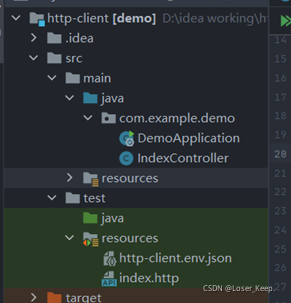idea 中的:HTTP Client,这款工具挺好用的,主要优点:
1、若想测试一个接口,只需要几行代码
2、运行特别容易
3、可以切换各种环境的请求地址
创建一个 springboot 项目

核心实现
IndexController
package com.example.demo;
import org.springframework.web.bind.annotation.*;
import org.springframework.web.multipart.MultipartFile;
import javax.servlet.http.HttpServletRequest;
import java.util.HashMap;
import java.util.List;
import java.util.Map;
/**
* @author ktz 2021/8/26
*/
@RestController
public class IndexController {
/**
* get请求
*/
@RequestMapping("/get")
public String get() {
return "[get]";
}
/**
* post请求,模拟表单提交
*/
@PostMapping("/post")
public Map<String, String[]> post(HttpServletRequest request) {
return request.getParameterMap();
}
/**
* post请求json数据
*/
@PostMapping("/body")
public List<Integer> body(@RequestBody List<Integer> list) {
System.out.println("[body]");
return list;
}
/**
* post请求json数据
*/
@PostMapping("/body2")
public String body(@RequestBody User user) {
System.out.println("[body2]");
System.out.println(user);
return "[success-body2]";
}
/**
* put请求
*/
@PutMapping("/put")
public String put() {
return "[send put]";
}
/**
* 模拟多文件上传,并带上表单数据
* 这个请求可以想象为页面中的一个表单提交,表单有 4 个元素:2 个 File 元素,用来选择需要上传的 2 个文件。2 个输入框,分别用来输入 userName 和 age。
*/
@PostMapping("/upload")
public Map<String, Object> upload(@RequestParam("file1") MultipartFile file1,
@RequestParam("file2") MultipartFile file2,
User user,
HttpServletRequest request) {
Map<String, Object> result = new HashMap<>(1);
result.put("file1.size", file1.getSize());
result.put("file1.name", file1.getName());//file1
result.put("file1.originalFilename", file1.getOriginalFilename());//pic_1.jpeg
result.put("file2.size", file2.getSize());
result.put("file2.name", file2.getName());//file2
result.put("file2.originalFilename", file2.getOriginalFilename());//pic_2.jpeg
result.put("user", user);
result.put("params", request.getParameterMap());//userName、age
return result;
}
static class User {
private String userName;
private int age;
public String getUserName() {
return userName;
}
public void setUserName(String userName) {
this.userName = userName;
}
public int getAge() {
return age;
}
public void setAge(int age) {
this.age = age;
}
@Override
public String toString() {
return "User{" +
"userName='" + userName + '\'' +
", age=" + age +
'}';
}
}
}
http-client.env.json
{
"dev": {
"url": "http://localhost:8080"
},
"test": {
"url": "http://localhost:9090"
}
}
index.http
### get 请求
GET http://localhost:8080/get
### post
### 提交表单数据,将表单内的数据转换为键值对,会封装到一个map中,比如 test=xxx&name=sss
POST http://localhost:8080/post
Content-Type: application/x-www-form-urlencoded
name=张三&age=23
### post
### 提交表单数据,将表单内的数据序列化为json字符串,会封装到@RequestBody标注的参数上,比如 {"test": "xxx"}
POST http://localhost:8080/body
Content-Type: application/json
[3,10,40]
### post
### 提交表单数据,将表单内的数据序列化为json字符串,会封装到@RequestBody标注的参数上,比如 {"test": "xxx"}
POST http://localhost:8080/body2
Content-Type: application/json
{
"userName": "ktz",
"age": 22
}
### put请求 服务实际使用端口为8080,因此dev环境测试成功
#PUT http://localhost:8080/put
PUT {{url}}/put
### 多文件上传文件
### boundary 表示参数和参数值定义范围的起始边界线,对应的默认值是 WebAppBoundary,也可以自定义,比如:WebAppBoundary123
### 如果有多个请求参数,各个参数需要使用--WebAppBoundary来作为它们的边界分隔符(前后都需要)
### 对应postman中的操作,选择一个文件,如何定位其位置呢?需要使用”<“这个符号
### 另外需要注意换行问题
POST http://localhost:8080/upload
Content-Type: multipart/form-data; boundary=WebAppBoundary
--WebAppBoundary
Content-Disposition: form-data; name="file1"; filename="x2.jpg"
< C:\Users\LOSER\Pictures\Saved Pictures\x2.jpg
--WebAppBoundary--
--WebAppBoundary
Content-Disposition: form-data; name="file2"; filename="x3.jpg"
< C:\Users\LOSER\Pictures\Saved Pictures\x3.jpg
--WebAppBoundary--
--WebAppBoundary--
Content-Disposition: form-data;name=userName
dg
--WebAppBoundary--
--WebAppBoundary--
Content-Disposition: form-data;name=age
23
--WebAppBoundary—
测试接口

?HTTP client 的使用
创建 http 后缀的文件,文件必须以 http 为后缀,这种文件会自动被 HTTP Client 插件识别,效果如下:

测试效果
 ??
??